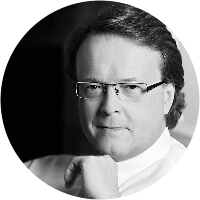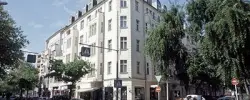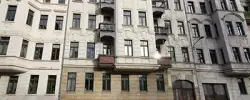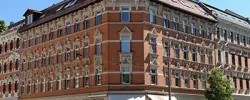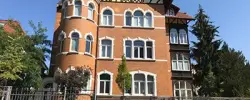Karlstraße 3
Return
4.75% p.a.
Duration
36 months
Project type
Income
Distribution
Quarterly
Notice according to § 12 (2) Vermögensanlagengesetz
This investment involves considerable risk and may result in partial or total loss.Project Presentation
The rented residential and commercial building is not only distinguished by its excellent location in the historic centre of Eisenach, but also by important visitors in the past: Goethe and Napoleon were guests in this very building (see picture gallery). The very well-kept house is located in the middle of the pedestrian zone in Eisenach and comprises 7 commercial units and one residential unit. The total usable space of the house is approx. 1,504 m² and it currently generates a net annual rent of about EUR 133,000, which corresponds to a net rent of just under EUR 8.87/m². Embedded in the pedestrian zone of Eisenach and in the immediate vicinity of important national and international chain stores, the house is in a sought-after location, from which all tenants in the house benefit.
Eisenach is located in the west of Thuringia and is the sixth largest city in Thuringia with about 43,000 inhabitants. Eisenach has been a district-free city since 1998 and is the center of western Thuringia. Eisenach is known for the Wartburg Castle above the city, which is a UNESCO World Heritage Site and was the seat of the Landgraves of Thuringia in the Middle Ages. It was there that Martin Luther translated the New Testament from Greek into German in the autumn of 1521. In 1817, the Wartburg festival took place there, one of the most important events of the pre-March period. Since February 2017, Eisenach has also been a university town, which leads to an increased influx of young people. In the course of industrialization in the second half of the 19th century, automobile factories gradually settled in Eisenach: first BWM, which built the "Wartburg" in Eisenach from 1928, and today Opel and Bosch, which employ 4,000 people in the region.
Location
Eisenach is located in the west of Thuringia and is the sixth largest city in Thuringia with about 43,000 inhabitants. Since 1998 Eisenach has been a county seat and is the centre of Western Thuringia. Eisenach is known for the Wartburg Castle above the city, which is a UNESCO World Heritage Site and was the seat of the Landgraves of Thuringia in the Middle Ages. It was there that Martin Luther translated the New Testament from Greek into German in the autumn of 1521. In 1817, the Wartburg festival took place there, one of the most important events of the pre-March period. Since February 2017, Eisenach has also been a university town, which leads to an increased influx of young people. In the course of industrialization in the second half of the 19th century, automobile factories gradually settled in Eisenach: first BWM, which built the "Wartburg" in Eisenach from 1928, and today Opel and Bosch, which employ 4,000 people in the region.
The best house on the square
In keeping with the MAGAN Group's corporate philosophy of "the best house on the square", Karlstraße 3 is also distinguished by its exceptionally good location within Eisenach. Embedded in the pedestrian zone and in the immediate vicinity of important national and international chain stores, the building is in a sought-after frequency location, from which the current tenants benefit. Thanks to the prime location in Eisenach, it has always been possible to retain tenants with good credit ratings for the long term.
Discover the surroundings
Wartburg
The Wartburg is a castle in Thuringia, situated above the town of Eisenach at the north-western end of the Thuringian Forest 411 m above sea level. It was founded around 1067 by Ludwig the Springer and has been a UNESCO World Heritage Site since 1999. Today's Wartburg Castle was largely rebuilt in the 19th century, including a few preserved parts. The present appearance of Wartburg Castle and its landscape park dates back to the Grand Duke Carl Alexander of Saxony-Weimar-Eisenach. Wartburg Castle has also acquired special historical significance because the reformer Martin Luther was imprisoned there for his own safety but originally against his will. He used the time in his sparse and spartanly furnished quarters to realize one of his most important projects: the translation of the New Testament into German.
City park
The Stadtpark is a historical landscape park in the centre of Eisenach in Thuringia. The city park is located east of the old town of Eisenach on the Pflugensberg. To the north, the city park extends as far as the historic development on Waldhausstraße with the future building site of the controversial Eisenach large-scale project "Gateway to the City" and as far as Eichrodter Weg near the freight station. Today's park is made up of three areas: the strip of woodland along Eichrodter Weg and the Riesengraben, which was reforested in the 19th century as the "Eisenacher Stadtwald", forms the eastern section of the park. In the centre is the city park, designed around 1880, with a playground, sunbathing areas and a network of paths. The western area originally belonged to the Villa Pflugensberg ("Eichelscher Garten"), it was purchased by the city administration in 1923. At the confluence of Stadtparkstraße and Karthäuserstraße (today Mitzenheimstraße into Wartburgallee) there is a semicircular open space as an entrance to the park, where the Bismarck monument was located from 1903 to 1963.
Bachhaus
The Bachhaus Eisenach is a museum in Eisenach, Thuringia, dedicated to the composer Johann Sebastian Bach, who was born there. It has 600 m² of exhibition space and displays around 250 original exhibits, including a Bach autograph for sheet music. The core of the museum, which today comprises several buildings, is an approximately 550-year-old half-timbered house (Frauenplan No. 21), which was falsely identified as Bach's birthplace in the middle of the 19th century. In 1907 the Leipzig New Bach Society established it as a memorial and Bach Museum.
Luther House
The Luther House in Eisenach is one of the oldest preserved half-timbered houses in Thuringia. According to tradition, Martin Luther lived here with the Cotta family during his school years from 1498 to 1501. Martin Luther spent several times in his "dear town" Eisenach, first as a young student and later in the Wartburg Castle, where he worked on his Bible translation.
City Hall
The town hall of the city of Eisenach is a listed building in Eisenach, Thuringia. Since the end of the 16th century it has served as the seat of the city administration and the (head) mayor of Eisenach. The town hall is located in the centre of Eisenach on the east side of the market at the entrance to Karlstraße, directly next to the Eisenach town castle and the building of the town pharmacy. It can be reached in a few minutes from the existing building at Karlstraße 3.
###Eisenach Central Station
Eisenach train station is the most important train station in the city of Eisenach in Thuringia. It is a transport hub and is located on the Thuringian Railway (Halle-Bebra) and on the Werra Railway (Eisenach-Meiningen-Eisfeld). It is the central hub of rail transportation in Thuringia and is maintained and operated by Deutsche Bahn. The six tracks are used for both regional trains and long-distance trains.
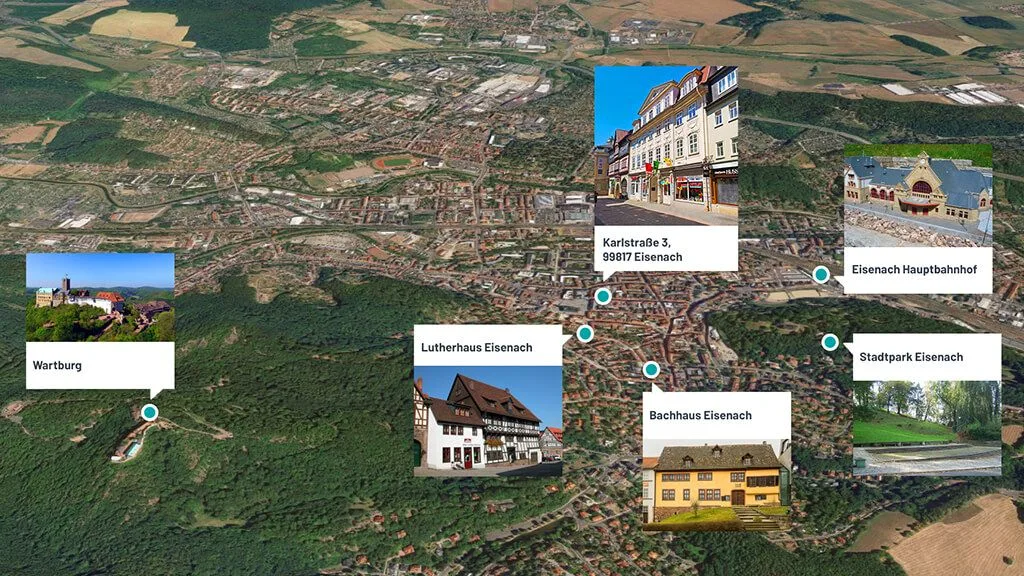
Team
Many years of real estate and financing experience in Germany
All in all, the management team of the MAGAN Group around the managing director and owner Alexander Neuhuber has decades of experience in the real estate industry, especially in Berlin and the new German states.
MAGAN Managing Director Alexander Neuhuber is one of the most well-known and distinguished real estate entrepreneurs in Austria. Already in 1988 he founded his first real estate agency "Neuhuber und Partner". In the early 1990s, Neuhuber succeeded in taking over the Austrian general representation of DTZ (Debenham Thorpe Zadelhoff, later Debenham Tie Leung), one of the largest global real estate consulting companies. In 2001, he sold the company, then ranked third in the list of the largest Austrian commercial real estate agents, to his British partners. Originally founded as a pure holding company for investments, Magan Holding GmbH was then the operative company of the group for a long time. In order to define the business areas even more clearly and to express this in the company name, Magan Holding GmbH will be renamed Magan Advisors GmbH in autumn 2018. With this company he advises a top-class clientele on the selection and execution of real estate transactions, as an investor or owner representative. A unique selling point is the support of Austrian investors in their purchases and sales in Germany. Since 2004 Neuhuber has also been active with the Magan group of companies in Berlin and the new federal states, and since 2014 he has also been operating a Magan office in Leipzig. The second pillar of the Magan Group can be described as private equity/club deals. In this context, real estate is purchased, managed and finally also sold again within the framework of changing investment companies, with various partners, on their own account.
Since autumn 2017 DI(FH) Michael Alexander Mitterdorfer has taken over the management of transaction management and investment of the MAGAN Group and can look back on more than 10 years of professional experience in the real estate industry. Through his career with well-known real estate companies such as EHL, Bank Austria Real Invest and BAR, he has been able to continuously expand his investment know-how and his international network. He was able to expand his German expertise most recently as head of real estate acquisition at Immowert Immobiliengruppe. As transaction manager he is responsible for the selection and execution of real estate transactions within the MAGAN group of companies and for MAGAN clients.
From 2005 to 2007, Mr. Neuhuber and his partner, the Austrian Stumpf Group, jointly acquired almost 70 apartment buildings in Berlin, Potsdam and Leipzig as part of a private equity investment. This resulted in a portfolio with approximately 1,500 existing units (Spree eins and two GmbHs and Wannsee GmbH). Following a phase of property optimisation and management, the sale of approx. 600 condominium apartments and the remaining properties in global sales will follow between 2011 and 2014. From the beginning of 2014, MAGAN and a new partner (Trabi Immobilien) purchased apartment buildings in Leipzig, Dresden, Halle and other cities. By summer 2016, a total of 33 properties in the new German states had been acquired and managed. In 2017 the portfolio was sold globally to a German institutional investor. Since 2016, the MAGAN Group has been acquiring mainly residential apartment buildings in the target markets through new private equity companies, the Horch Group. To date, more than 30 properties have been purchased, and a partial package in Leipzig was already sold again at the end of 2018.
An additional, newer pillar of MAGAN is the Wartburg Group, with which individual condominiums are acquired - again in the form of a club deal. By the beginning of 2020, more than 120 condominiums have already been purchased in the cities of Leipzig, Dresden, Chemnitz, Magdeburg, Halle, Chemnitz, Zwickau, and Gera.

MAGAN Gruppe
